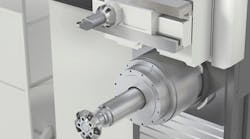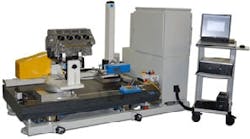Machining technology developer MAG is due to introduce an integrated contouring head for horizontal mills, one that improves on the reach and power of its boring spindles. The new contouring head will be available for MAG horizontal boring mills in 1,250-mm and 1,600-mm (49.1 in., 63 in.) table/pallet sizes; and live-spindle HMCs with 800- to 1,600-mm (31.5- to 63-in.) pallets.
MAG will present he new design at SME’s Houstex event, February 26-28.
Noting that the new device is the only one of its kind for machining, MAG detailed that it has a standard tool interface reduces tooling costs significantly. It also loads tools via the machine's automatic tool-changer for faster processing without operator involvement.
The contouring spindle's U-axis slide stroke makes it possible to produce small- or large-diameter features without changing tool heads or other manual intervention, so complex features can be machined in one setup — with reduced cycle time and labor.
MAG said its new contouring head produces features like bottle bores, valve seats, seal faces, phonographic sealing surfaces, O-ring grooves, straight/tapered threads, chamfers, and external profiles, among others. It is especially well suited to single-setup, rough and finish machining of parts for oil-and-gas sector applications, or any large-dimension part that combines bored, milled, and turned features.
The integrated contouring head will be available with a standard Kennametal KM80™ or Sandvik Coromant® Capto C8 tool interface. Also, the live boring spindle can use 50-taper tools as long as 750 mm (29.5 in), and an auto-coupler provides the interface for feed-out tools, such as programmable boring bars.
"The contouring head is engineered as a drop-in module that can be added during manufacture or later, as well as removed for service without affecting operation of the boring spindle,” explained Pete Beyer, MAG’s director of product strategy and product development. "A simple shifting mechanism allows it to be powered by the main spindle motor, reducing complexity and cost.
“In addition to providing greater slide stroke than other machines or add-on contouring heads, our design includes a slide counterbalance to offset centrifugal force, ensuring optimum part roundness and accuracy,” Beyer continued. “Overall, the integrated contouring head is a great advance over current boring mill technology, which would require two auxiliary heads to produce the same diameter range; a head changing system and storage rack; manual tool changes; and proprietary tools to provide the same functionality. We are reducing mechanical complexity, floor space, cycle time, tooling costs, and labor, while improving part quality."
For boring mills and HMCs, the contouring spindle is positioned immediately above the machine's main spindle — but slightly offset in the Y and W/Z axes to avoid tool interference.
The rated power will be 56 kW/75 hp (S6-40%) on boring mills, and 45 kW/60 hp (S6-40%) on HMCs. A touch probe may be used in the boring spindle or on an auxiliary arm to measure parts’ machined features, in process or post-processing. Standard services like coolant supply are plumbed through the contouring head to eliminate manual intervention and ensure maximum tool life.








